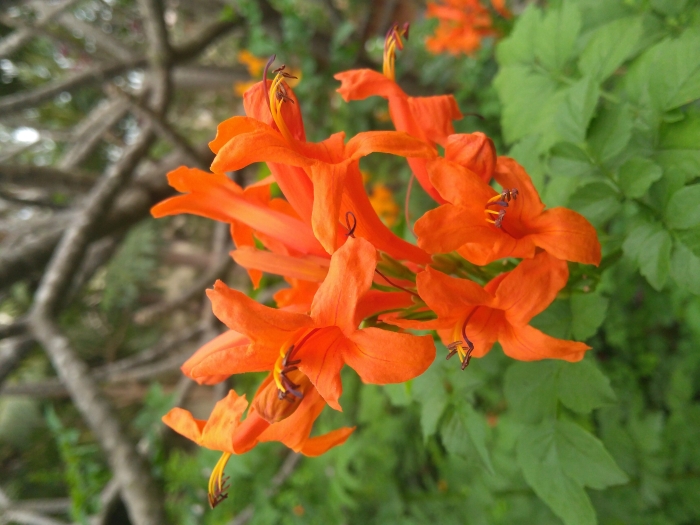Cape Honeysuckle
(Tecoma capensis)
Cape Honeysuckle (Tecoma capensis)
/
/

SKsiddhartthan
CC BY-SA 4.0
Image By:
SKsiddhartthan
Recorded By:
Copyright:
CC BY-SA 4.0
Copyright Notice:
Photo by: SKsiddhartthan | License Type: CC BY-SA 4.0 | License URL: https://creativecommons.org/licenses/by-sa/4.0 | Uploader: SKsiddhartthan | Publisher: Wikimedia Commons | Title: Cape_honeysuckle.jpg | Notes: User created page with UploadWizard |






















































Estimated Native Range
Summary
Tecoma capensis, commonly known as Cape Honeysuckle, is an evergreen perennial vine or shrub native to the coastal forests, forest edges, and riverbanks of Southern Africa. It is an erect, scrambling shrub that typically grows to 2–3 m (7–10 ft) in height and width. While usually evergreen, it may become deciduous in colder climates. Cape Honeysuckle is characterized by its tubular flowers, which are about 7.5 cm (3 in) long and range in color from orange to orange-red to apricot. These showy flowers are produced sporadically throughout the year, with peaks in flowering season depending on the local climate.
Cape Honeysuckle is valued for its vibrant flowers and ability to attract hummingbirds and other pollinators. It is commonly used for hedging and screening, and its scrambling habit allows it to cover trellises, fences, and walls, providing a lush, tropical appearance. However, it can appear untidy if not pruned regularly. Pruning in late winter encourages new growth and abundant flowering. A balanced fertilizer post-pruning will boost growth. It is adaptable to semi-shade to full sun and prefers medium water and well-drained soils. While it tolerates temperatures down to 5 °C (41 °F), in cooler climates, it benefits from the protection of a warm wall or can be grown in a container and moved indoors during winter. Tecoma capensis can be propagated from cuttings or by removing rooted suckers during the active growth phase. Gardeners should be aware that it can become invasive outside its native range, particularly in warm, frost-free regions.CC BY-SA 4.0
Cape Honeysuckle is valued for its vibrant flowers and ability to attract hummingbirds and other pollinators. It is commonly used for hedging and screening, and its scrambling habit allows it to cover trellises, fences, and walls, providing a lush, tropical appearance. However, it can appear untidy if not pruned regularly. Pruning in late winter encourages new growth and abundant flowering. A balanced fertilizer post-pruning will boost growth. It is adaptable to semi-shade to full sun and prefers medium water and well-drained soils. While it tolerates temperatures down to 5 °C (41 °F), in cooler climates, it benefits from the protection of a warm wall or can be grown in a container and moved indoors during winter. Tecoma capensis can be propagated from cuttings or by removing rooted suckers during the active growth phase. Gardeners should be aware that it can become invasive outside its native range, particularly in warm, frost-free regions.CC BY-SA 4.0
Plant Description
- Plant Type: Vine, Shrub
- Height: 6-30 feet
- Width: 3-7 feet
- Growth Rate: Moderate, Rapid
- Flower Color: Orange, Red, Yellow
- Flowering Season: Spring, Summer, Winter
- Leaf Retention: Evergreen
Growth Requirements
- Sun: Full Sun, Part Shade
- Water: Medium
- Drainage: Medium
Common Uses
Bee Garden, Bird Garden, Butterfly Garden, Deer Resistant, Drought Tolerant, Fire Resistant, Hedges, Hummingbird Garden, Low Maintenance, Potted Plant, Salt Tolerant, Showy Flowers, Street Planting
Natural Habitat
Coastal forests, forest edges, and riverbanks of Southern Africa
Other Names
Common Names: Cape Trumpet-Flower, Jazmin Trompeta, Tecoma, Bignone, Bouquet, Chèvrefeuille Du Cap, Jasmin Du Cap, Técome, ‘I‘Iwi Haole
Scientific Names: , Tecomaria capensis, Tecoma capensis, Bignonia capensis, Ducoudraea capensis, Gelseminum capense, Gelsemium capense, Tecoma petersii, Tecomaria capensis var. flava, Tecomaria krebsii
GBIF Accepted Name: Tecoma capensis (Thunb.) Lindl.